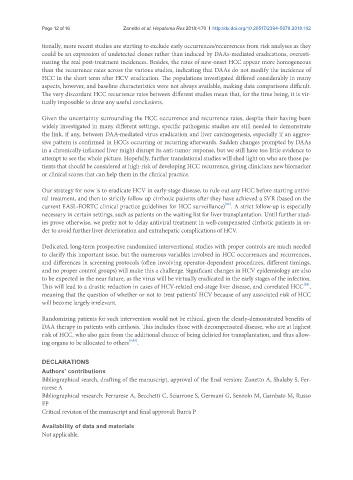Page 792 - Read Online
P. 792
Page 12 of 16 Zanetto et al. Hepatoma Res 2018;4:70 I http://dx.doi.org/10.20517/2394-5079.2018.102
tionally, more recent studies are starting to exclude early occurrences/recurrences from risk analyses as they
could be an expression of undetected clones rather than induced by DAAs-mediated eradications, overesti-
mating the real post-treatment incidences. Besides, the rates of new-onset HCC appear more homogeneous
than the recurrence rates across the various studies, indicating that DAAs do not modify the incidence of
HCC in the short term after HCV eradication. The populations investigated differed considerably in many
aspects, however, and baseline characteristics were not always available, making data comparisons difficult.
The very discordant HCC recurrence rates between different studies mean that, for the time being, it is vir-
tually impossible to draw any useful conclusions.
Given the uncertainty surrounding the HCC occurrence and recurrence rates, despite their having been
widely investigated in many different settings, specific pathogenic studies are still needed to demonstrate
the link, if any, between DAA-mediated virus eradication and liver carcinogenesis, especially if an aggres-
sive pattern is confirmed in HCCs occurring or recurring afterwards. Sudden changes prompted by DAAs
in a chronically-inflamed liver might disrupt its anti-tumor response, but we still have too little evidence to
attempt to see the whole picture. Hopefully, further translational studies will shed light on who are those pa-
tients that should be considered at high-risk of developing HCC recurrence, giving clinicians new biomarker
or clinical scores that can help them in the clinical practice.
Our strategy for now is to eradicate HCV in early-stage disease, to rule out any HCC before starting antivi-
ral treatment, and then to strictly follow up cirrhotic patients after they have achieved a SVR (based on the
[93]
current EASL-EORTC clinical practice guidelines for HCC surveillance) . A strict follow-up is especially
necessary in certain settings, such as patients on the waiting list for liver transplantation. Until further stud-
ies prove otherwise, we prefer not to delay antiviral treatment in well-compensated cirrhotic patients in or-
der to avoid further liver deterioration and extrahepatic complications of HCV.
Dedicated, long-term prospective randomized interventional studies with proper controls are much needed
to clarify this important issue, but the numerous variables involved in HCC occurrences and recurrences,
and differences in screening protocols (often involving operator-dependent procedures, different timings,
and no proper control groups) will make this a challenge. Significant changes in HCV epidemiology are also
to be expected in the near future, as the virus will be virtually eradicated in the early stages of the infection.
[94]
This will lead to a drastic reduction in cases of HCV-related end-stage liver disease, and correlated HCC ,
meaning that the question of whether or not to treat patients’ HCV because of any associated risk of HCC
will become largely irrelevant.
Randomizing patients for such intervention would not be ethical, given the clearly-demonstrated benefits of
DAA therapy in patients with cirrhosis. This includes those with decompensated disease, who are at highest
risk of HCC, who also gain from the additional chance of being delisted for transplantation, and thus allow-
ing organs to be allocated to others [9,95] .
DECLARATIONS
Authors’ contributions
Bibliographical search, drafting of the manuscript, approval of the final version: Zanetto A, Shalaby S, Fer-
rarese A
Bibliographical research: Ferrarese A, Becchetti C, Sciarrone S, Germani G, Senzolo M, Gambato M, Russo
FP
Critical revision of the manuscript and final approval: Burra P
Availability of data and materials
Not applicable.

